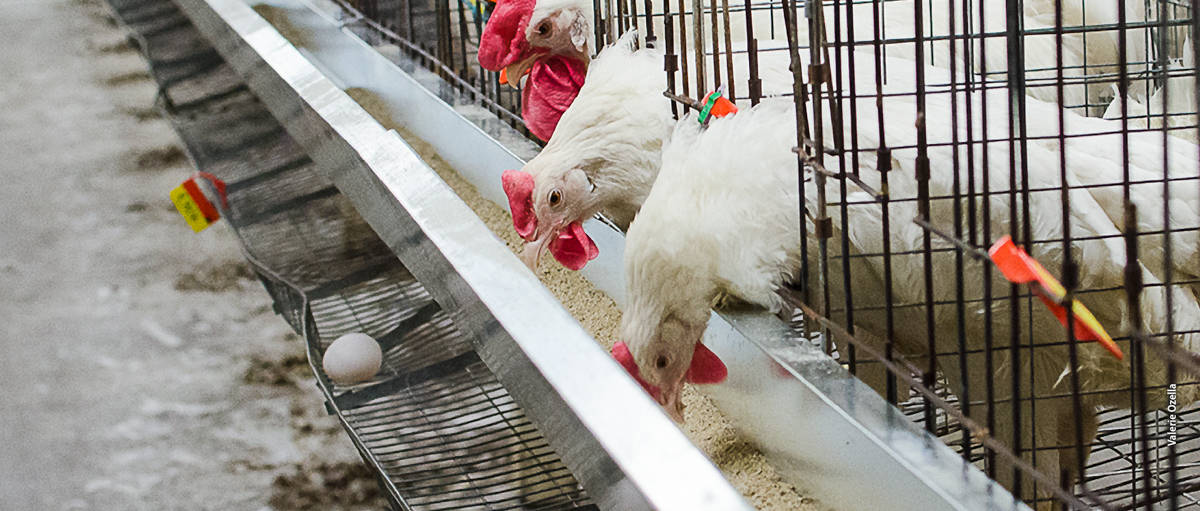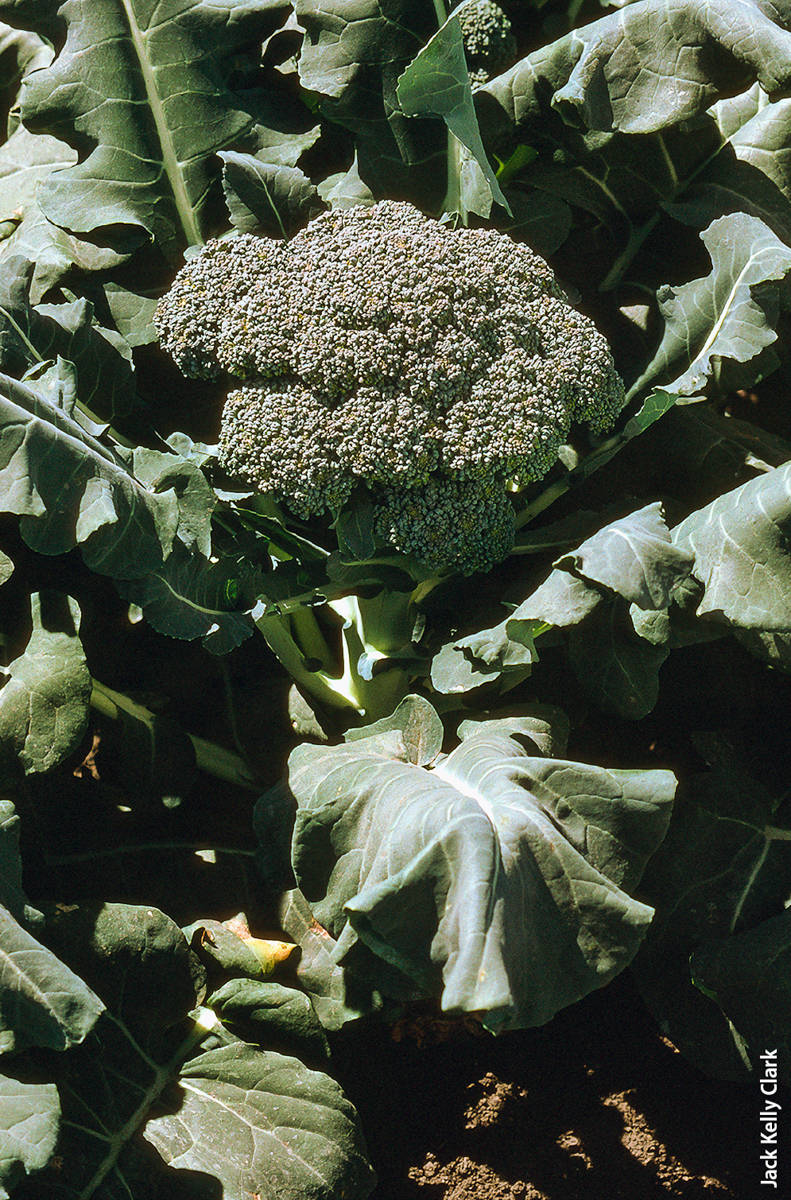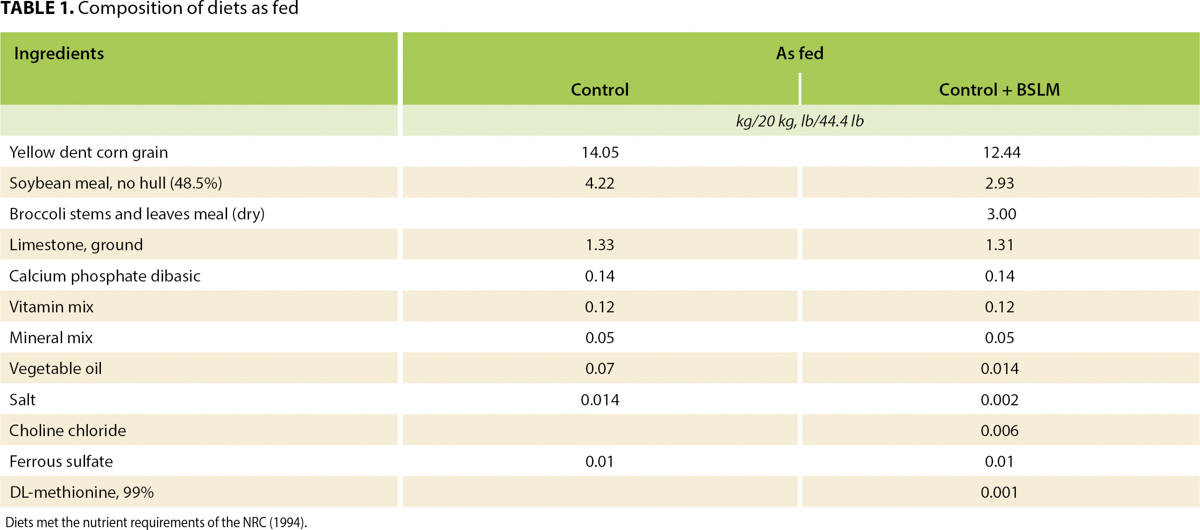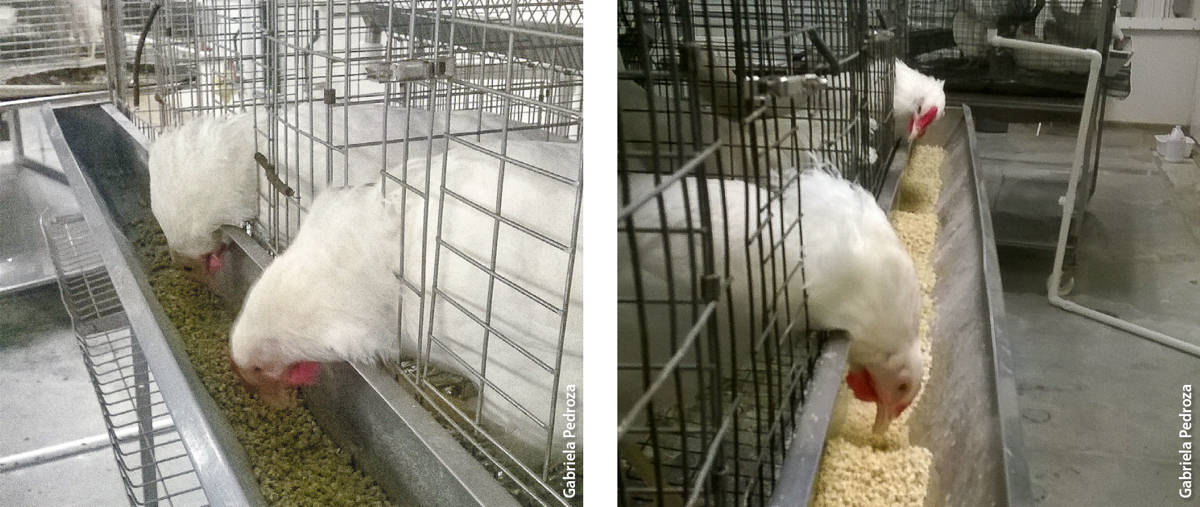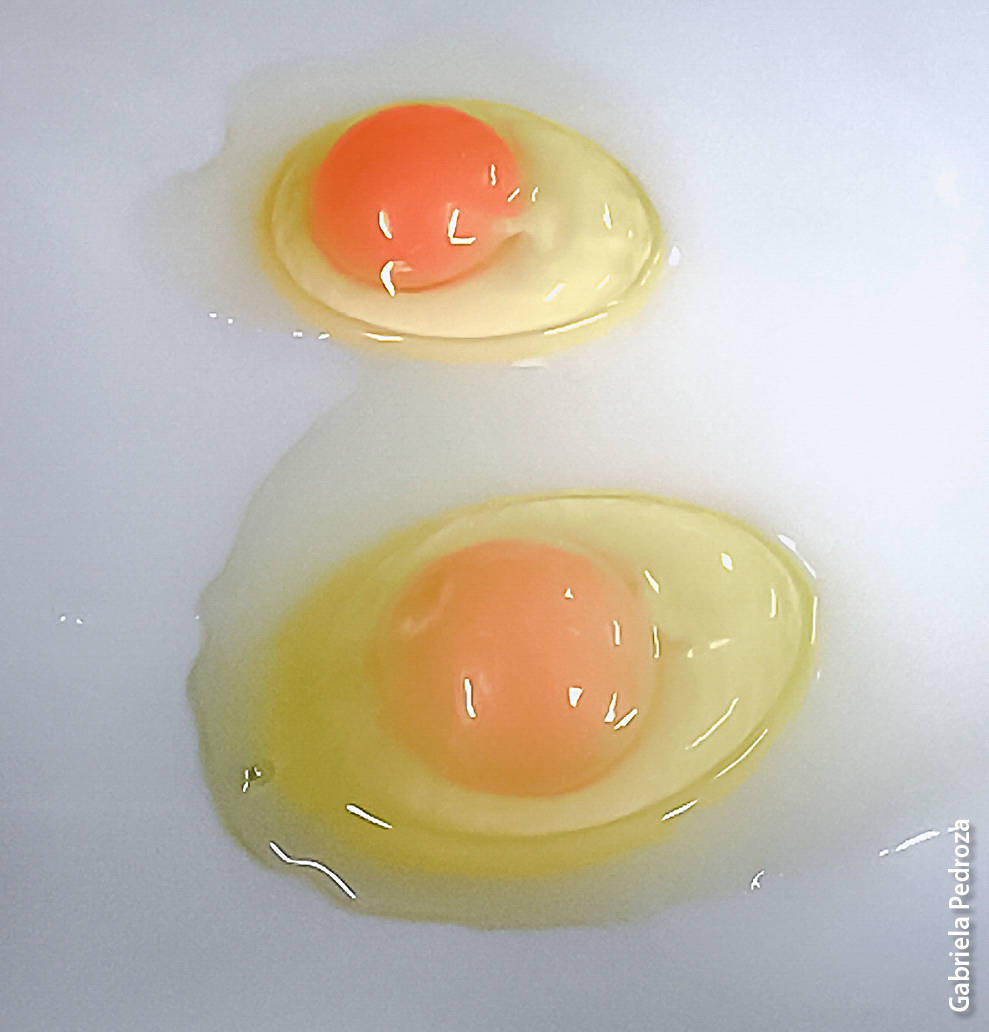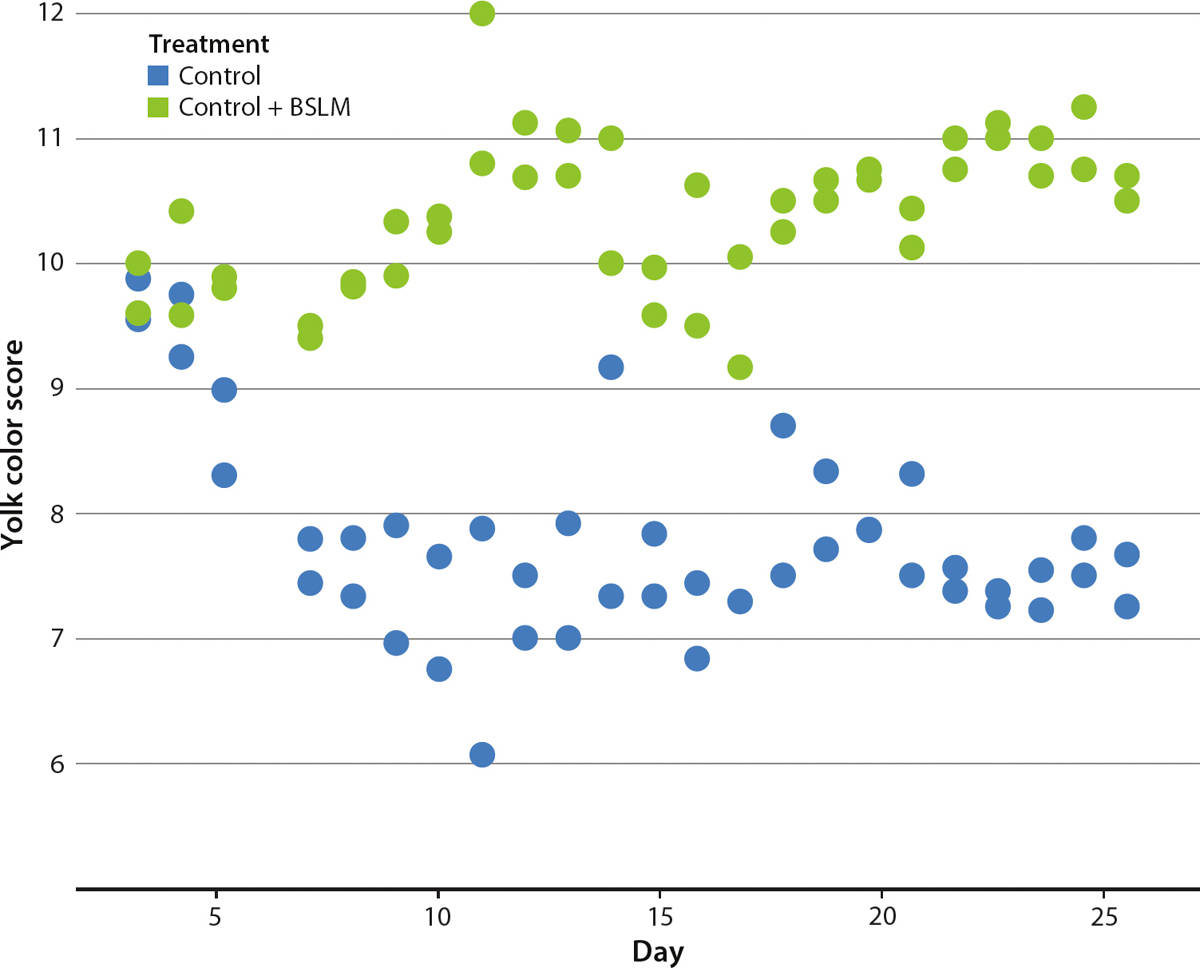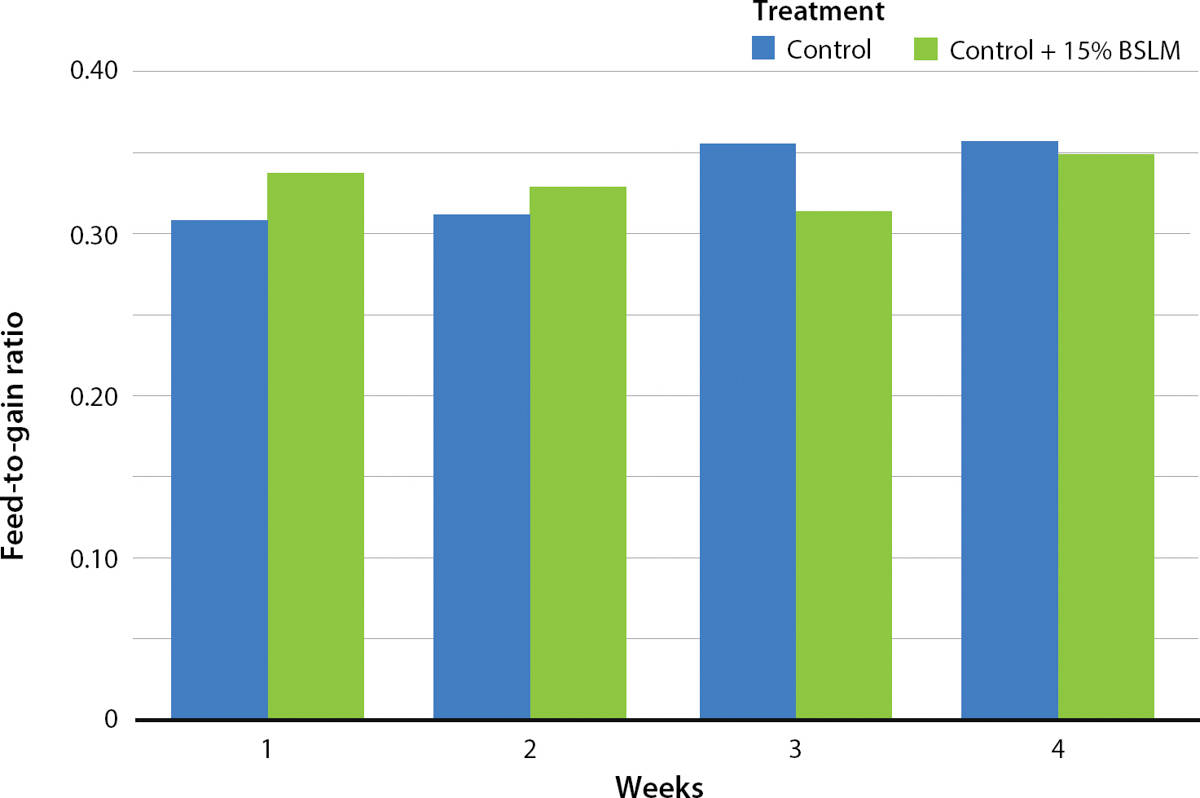All Issues
Broccoli meal fed to laying hens increases nutrients in eggs and deepens the yolk color
Publication Information
California Agriculture 72(4):243-247. https://doi.org/10.3733/ca.2018a0024
Published online December 17, 2018
PDF | Citation | Permissions
NALT Keywords
Abstract
The nutritious stems and leaves of broccoli often go to landfills as byproducts after harvesting and processing of the florets. The stems and leaves contain specific carotenoids that are noted to have anti-allergic, anti-cancer and anti-obesity bioactivity. Research has shown the stems and leaves could be made into a meal, small amounts of which could be added to poultry diets to increase the nutrients in eggs and also deepen the color of the yolks. We studied adding a relatively high percentage (15%) of broccoli stem and leaves meal to the corn-soy diets of White Leghorn inbred crosses. Compared to the control group of hens, fed the unenhanced corn-soy diet, feed consumption, body weight, feed conversion, egg production, egg weight, albumen height, Haugh units and eggshell thickness were statistically similar. No harmful effects of the glucosinolates in broccoli were observed. Yolk color scores were significantly higher with the addition of the meal. The results justify larger studies with various commercial lines of laying hens and various levels of meal added to the diets.
Full text
During the harvesting and processing of broccoli (Brassica oleracea), the florets are separated out for consumption, leaving the stems and leaves, an estimated 75% of the plant, to be returned to the soil (Richard Smith, UC Cooperative Extension, personal communication). In spite of their high levels of calcium, vitamins, coloring agents, carotenoids and antioxidants, the stems and leaves are often deposited in landfills (AgMRC 2017; USDA ARS 2015; Wu et al. 1992). U.S. governmental agencies have called for a reduction of this type of agricultural byproduct waste, to use it to feed more people and to reduce the quantities of it in landfills, which emit greenhouse gases that are harmful to the environment and ultimately to people (USDA and US EPA 2015). Instead of being wasted, broccoli stems and leaves could be turned into meal and added to poultry diets.
Broccoli contains carotenoids that are yellow, orange or deep red (these colors are invisible because they are masked by chlorophyll's green reflection of sunlight). Diets containing various carotenoids are fed to laying hens to deepen the yellow-orange color of the egg yolk, which is desired by consumers and food companies. Poultry farmers can use lutein in marigold and alfalfa extracts to produce darker yolks. Other carotenoids are found in corn and red pepper (Nimalaratne et al. 2012). Regulations permit use of synthetic carotenoids; however, they are expensive. Many researchers agree that discarded vegetables and fruits are good sources of natural carotenoids to increase yolk pigmentation (Calislar and Uygur 2010; Gonza et al. 1999; Hu et al. 2011; King and Griffin 2015; Lokaewmanee et al. 2010).
According to UC Davis researchers, adding broccoli stems and leaves meal to poultry diets can increase the amount of carotenoids in eggs.
California produces 90% of the broccoli grown in the United States (AgMRC 2017; Le Strange et al. 2010). Feeding of some byproducts will need to follow regulatory guidelines (US FDA 2018). Limitations for use of various byproducts include legality of use, health hazards, anti-nutritional factors, consistency, ability to form pellets, palatability, quality and quantity of byproduct and effect of feed on resultant quality of food (Chedly 2001).
Used as a carotenoid supplement in poultry diets, broccoli stems and leaves meal (BSLM), a no-cost byproduct that has to be hauled to landfills, could be financially advantageous for both producers of conventionally produced or organic eggs. For consumers, there are also health benefits. Epidemiologic and animal studies revealed that carotenoids in diets are antioxidants, inhibit premalignant lesions and enhance immune responses. Specific dietary carotenoids also provide protection against macula degeneration (Kotake-Nara and Nagao 2011; Seddon 1994; Snodderly 1996). Some carotenoids, in particular, have attracted interest from health professionals due to their anti-allergic, anti-cancer and anti-obesity actions (Kotake-Nara and Nagao 2011). Specific carotenoids in broccoli have been shown to be less affected by heat (frying, boiling and heating by microwave), with losses ranging from 6% to 18% less than losses of other broccoli carotenoids (Bailey and Chen 1989; Karadas et al. 2006). In contrast to vegetable matrices, carotenoids in egg yolks are highly digestible and bioactive (Thierau et al. 2014; Zaripheh and Erdman 2002).
Research suggests BSLM can only be a small part of poultry diets. Plants in the Brassica family possess secondary plant metabolites, glucosinolates, which have been shown to severely depress growth, reduce feed intake and decrease egg production if fed indiscriminately to poultry (Tripathi and Mishra 2007). However, Hu et al. (2011) fed laying hens diets with 0% to 9.0% BSLM and reported statistically similar egg production and egg quality measurements, and significantly darker yolk pigmentation with BSLM.
According to Hu et al. (2011), glucosinolates increase as the quantity of BSLM fed to layers increases. At 9%, there was 6.75 × 10−7% of glucosinolate (based on molecular weight of methylglucosinolate) in the diet. This was well below the 1.62 × 10−6% of glucosinolates in the diet considered detrimental to poultry health and production (Tripathi and Mishra 2007). If the amount of BSLM in the diet were 18%, twice that used by Hu et al. (2011), a linear association shows that the concentration of glucosinolates in the diet would be approximately 1.35 × 10−6%, still below that reported to be harmful for poultry.
In a small study in the Department of Animal Science at UC Davis, we investigated the effects of increasing BLSM in poultry diets to 15%. Diets were fed to White Leghorn inbred crosses, similar in size and production characteristics to commercial layers. Our goal was to determine whether larger-scale research was warranted with various commercial layers and levels of BLSM in the diet.
Broccoli meal (BSLM) trial
All animal feeding and handling procedures in the study were approved by the Institutional Animal Care and Use Committee. Isoenergetic and isonitrogenous diets were formulated at UC Davis (Creative Formulation Concepts 2015, table 1). Diets were formulated as corn-soy (control) and the control plus 15% BSLM purchased at Harmony House (Franklin, N.C.). Diets were provided in three replicates to four hens in two runs of the experiment (table 1).
Hens were housed in individual cages (18 by 19 by 21 inches) in the same house, with a temperature range of 20°C to 25°C and 18 hours of light and 6 hours of darkness during each 24-hour cycle. Hens were allowed to acclimate to diets for approximately 4 days before measurements were taken; feed and water were provided ad libitum for 4 weeks.
Total carotenoids in diets were determined on pooled samples from each replication of the diet using the method and equation described by de Carvalho and Gomes (2012). Weekly weights of hens were recorded. Eggs were collected daily, then labeled and stored at 4°C. Egg weight, albumen height, Haugh units, eggshell thickness and yolk color were determined within 3 days of egg collection. The Haugh unit, an overall measure of internal egg quality, was determined using the following equation:
HU = 100*log10 (h − 1.7w0.37 + 7.6)
where h is height of albumen and w is egg weight (Eisen et al. 1962).
Eggshell thickness was determined following the method of Sun et al. (2012). Two measurements for thickness were made at the equatorial center of each eggshell using a digital caliper. A YolkFan (DSM Nutritional Products, Parsippany, N.J.) was used to rate yolk color relative to 15 standards. Ratings were obtained from separate blind measurements by two people.
A formulated corn and soy feed, right, was the control in a trial to assess adding BSLM (broccoli stems and leaves meal), left, to a poultry diet. The BSLM increased egg yolk color with no detrimental effects on egg production or quality.
All data, except eggshell thickness, were analyzed using R-3.2.1 (RStudio Team 2015). For the power analysis (12 birds per treatment, alpha of 0.05 and a power value of 0.8), the computed d value [(treatment 1 – treatment 2)/standard deviation] was 1.19, an estimate of the detectable difference in standard deviation units. Data were collected from a second run of the experiment with layers (a total of 24 for each treatment) to improve the accuracy of differences as calculated. Shell thickness was analyzed by ANOVA (SAS, Cary, N.C.). Means for all data were calculated and significant differences between treatments were determined for 95% accuracy (P < 0.05).
More carotenoids, deeper yolk color
Eggs laid by hens fed a diet enhanced with 15% BSLM (broccoli stems and leaves meal) had a darker yolk (top) than eggs laid by hens fed a diet without BSLM (bottom).
Total carotenoids were statistically different at 1.11 × 10−3, 2.56 × 10−4, 4.10 × 10−5 and 9.77 × 10−5 pounds of total carotenoid per 100 pounds of BSLM, the control plus 15% BSLM, cornmeal, and a corn-soy commercial diet, respectively. The control plus 15% BSLM diet provided approximately 2.6 times more carotenoids than the commercial diet. BSLM has approximately 27 times more carotenoids when compared to cornmeal.
As shown in figure 1, color scores for egg yolks were significantly different throughout the trial. For the final 10 days, color scores were 7.70 ± 0.35 and 10.60 ± 0.36 for the control and control plus 15% BSLM, respectively.
FIG. 1. A YolkFan was used to rate yolk color relative to 15 standards. The addition of BSLM (broccoli stems and leaves meal) to the poultry diet resulted in significantly higher scores.
After feeding BSLM in diets, Hu et al. (2011) reported yolk color scores of 9.25, 10.39, 10.92 and 11.28 for 0%, 3%, 6% and 9% BSLM, respectively. Our value for the control was lower than the value in that study for 0% BSLM. The difference may be due to the different groups of observers ranking differently or to hen strain, hen age or other factors. The similarity between the study's 9% BSLM score (Hu et al. 2011) and our score for 15% BSLM may indicate an upper limit for the deposition of carotenoids in egg yolk. Clearly, further investigation is warranted.
Egg production and quality maintained
Feed intake and weight gain were not significantly different for the two diets. The insignificant difference for the feed conversion ratio is shown in figure 2. Egg production, egg weight, albumen height and Haugh units were not affected by adding 15% BSLM to the commercial diet. Values for eggshell thickness were similar at 0.36 ± 0.05 and 0.37 ± 0.06 millimeters for the control and the experimental diet, respectively.
FIG. 2. Feed consumption and weight gained were determined weekly and the feed conversion ratio was calculated for the two treatments: the control, a commercial corn-soy feed, and the control plus 15% BSLM (broccoli stems and leaves meal). There was no significant difference between the treatments.
Nutritional impact, future research
Our study findings supported our hypothesis that 15% BSLM would not decrease hen growth, production and other egg quality measurements, but it would deepen the egg yolk color and greatly increase the carotenoids in eggs. Increasing the nutritional value of eggs would be especially important for people not consuming enough carotenoids from fruits and vegetables. Continued research on BSLM as a component of poultry diets promises to be important for U.S. consumption of carotenoids as well as for consumers in parts of the world where the nutrients in BSLM-enriched eggs would be important for overall improvements in health. Our results suggest that our research should continue with a full-scale study using commercial White Leghorns.
As mentioned earlier, theoretically, almost 20% BSLM could be added to layer diets without detrimental effects on growth, production measurements and egg quality. Ongoing research will include (1) adding varying quantities (10% to 20%) of BSLM to diets of commercial layers and determining the corresponding concentration of specific carotenoids in the egg yolks, (2) examining the upper limit of carotenoid deposition and the medical effects of glucosinolates, and (3) determining the quantity of carotenoids in eggs before and after heating by various methods.



